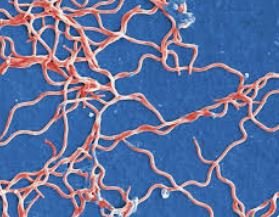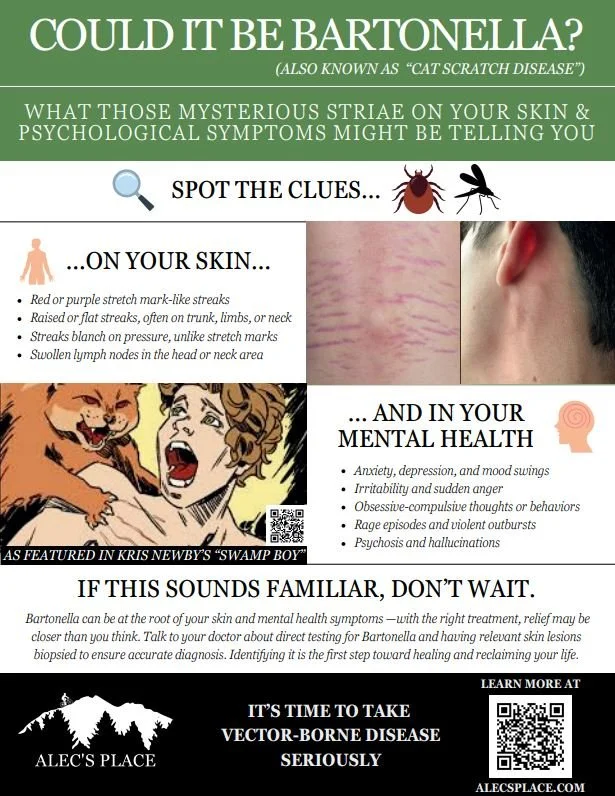
Bartonella: The Overlooked Vector-Borne Co-Infection Driving Neurologic Symptoms
Bartonella is a common co-infection in Lyme disease, Bartonellosis is a poorly understood and is routinely overlooked by mainstream medicine. As a result, many cases go undiagnosed, leading to significant and unnecessary human suffering and substantial costs to society. Bartonella is known to be immunosuppressive in humans, carrying the risk for disseminated metabolic and mental health complications
Bartonella can present in many different ways. But the range (of symptoms) is quite substantial. From joint pain, skin lesions of different kinds. All the way up to a full-blown neuropsychiatric illnesses including schizophrenia and psychosis. And even, worst case scenarios, suicide.
Bartonellosis is underdiagnosed, causing significant suffering and costs. Symptoms vary widely, from joint pain and skin lesions to severe neuropsychiatric issues like schizophrenia, psychosis, and even suicide. Common signs include swollen lymph nodes, gastritis, sore feet, muscle twitching, headaches, abdominal pain, skin rashes, tender nodules, fever, anxiety, depression, anger, and obsessive-compulsive behaviors.
Early vs. Late Bartonella Disease Symptoms: What to Watch For!
-
(Often weeks to months after a tick, flea, or cat scratch bite)
Red or streaked rash (papules, nodules, or “cat scratch” lesions) near entry site
Swollen, tender lymph nodes (commonly neck, armpit, or groin)
Low-grade fever, fatigue, or malaise
Headache and muscle aches
Eye irritation or conjunctivitis
Mild digestive upset (nausea, poor appetite)
Irritability, anxiety, or mood swings
Restlessness or sleep disturbance
-
(Months to years after infection; symptoms may fluctuate)
Migratory pain in joints, tendons, or bones (especially feet, shins, ribs)
Neuropathic pain (burning, stabbing, or vibrating sensations)
Vasculitic rashes or red streaks resembling stretch marks (striae)
Eye involvement: blurred vision, light sensitivity, retinal inflammation
Persistent fatigue, dizziness, or exercise intolerance
Cognitive dysfunction: short-term memory loss, confusion, brain fog
Emotional instability: anxiety, panic attacks, OCD, or depression
Gastrointestinal distress or alternating constipation/diarrhea
Swollen lymph nodes or spleen enlargement
Palpitations or chest pressure
-
(Chronic or severe systemic phase with nervous system, vascular, and immune involvement)
Small-vessel inflammation (vasculitis) affecting skin, eyes, and brain
Neuropsychiatric symptoms: agitation, rage, psychosis, hallucinations, or derealization
Seizures, tremors, or movement disorders
Peripheral neuropathy: burning or numbness in limbs, facial pain, or muscle weakness
Insomnia, circadian rhythm inversion, vivid dreams or night terrors
Autonomic dysfunction (POTS, temperature dysregulation, fainting)
Migratory pain in bones, tendons, and soles of feet (“foot pain on waking”)
Cognitive impairment: executive dysfunction, poor concentration, memory gaps
Immune dysregulation leading to PANS/PANDAS-like syndromes
Endothelial inflammation causing vascular instability, blood pooling, or petechiae
Visual or auditory disturbances (flashes, floaters, tinnitus)
Psychiatric misdiagnoses including bipolar, schizophrenia, or PTSD-like presentations
Could It Be Bartonella?
Wondering if symptoms link to Bartonella? This free, clear poster highlights signs like stretch-mark–like striae, inflamed nodules, and skin changes, plus their connection to mood and mental health. A visual guide for unexplained symptoms.











